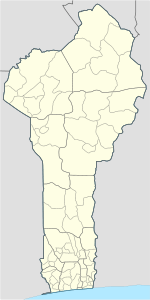Parakou
Parakou is the largest city in northern Benin, with an estimated population of around 206,667 people, and capital of the Borgou Department. Administratively the commune of Parakou makes up one of Benin's 77 communes. Since 2015, its mayor is Souradjou Adamou Karimou.
Parakou | |
|---|---|
 Central Parakou | |
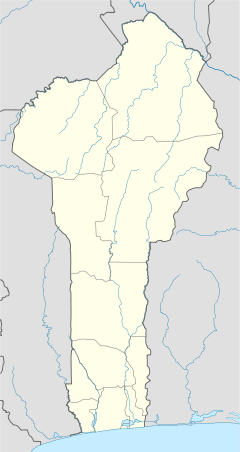 Parakou Location in Benin | |
| Coordinates: 9°21′N 2°37′E | |
| Country | |
| Department | Borgou Department |
| Area | |
| • Total | 441 km2 (170 sq mi) |
| Elevation | 324 m (1,063 ft) |
| Population (2012)[1] | |
| • Total | 206,667 |
| • Density | 470/km2 (1,200/sq mi) |
| Time zone | UTC+1 (WAT) |
History
The foundation of the city dates back to the 16th century by traders.[2]
Even the throne of Sinaguruu is not recognized as a wasangari throne by the blood tie, the kingdom of Parakou (KƆRƆKU TEM) has almost the same structure as all the other wasangari kingdoms of Baruwuu such as Kwande, Kandi, etc. . Indeed, there is the throne of the political and administrative chief (the Akpaki whose palace is located in the Sinaguruu district of the city of Parakou) and the throne of chief of land (the Gbeeguruu Sunɔ or Sina Wobagi whose palace is located Gbeeguruu in N'Dali commune; but their initial site was at Kɔmi-Gea on the northern outskirts of the city of Parakou). The particularity of Parakou (KƆRƆKU TEM) is that there is also a deputy or executive head of land (the Kpebie Sunɔ whose palace is in the Kpébié district of the city of Parakou).
The first king of Parakou having been an adopted son of Nikab's Sinaboko, received a pure Wasangari education. Before gaining the throne of Sinaguruu in Parakou, he held the title of Gɔɔbiru (nobility) to which any Wasangari prince aspires to aspire to Nikki's imperial throne later. This was the title of "Kpaasɔɔ" commonly known as "Passo" these days. According to Professor Léon Bio Bigou, he would be the first prince to carry this title of nobility near the imperial court of Sinaboko. In addition to this title, he received some princely attributes: the black iron stirrups, the Bente (thick cloth band used to cover the back of the horse to the end of the tail) and the Yankokoru, that is- ie the gon.
After he left the capital Nikki and settled in Sinaguruu (Parakou) with the status of political and administrative chief to maintain him in the baatɔnu / bariba environment which raised him, KpaasƆƆ, the Gɔɔbi (Noble) was invested with the title of Akpari Koburu. Also, the Sinaboko (who came from the Makararu dynastic branch) and his court decided to keep him in the lap of Nikki and institutionalized him on behalf of the Makararu dynastic branch with the same attributes as the princes of this branch dynastic. Thus, the black iron stirrups (hierarchically lower) have been replaced by the white copper stirrups (hierarchically higher). This is the origin of this princely title KpaasƆƆ in the Makararu dynastic branch.
Even the Bariba constitute the majority of the population of the kingdom, traders of various origins (Hausa, Zarma / Dendi, Yoruba, Gurmache, Mandingo, etc.) have contributed a little bit to economic prosperity and development of the kingdom of Parakou. The Peulh and Nagot also are an integral part of the kingdom. Nowadays, there are also people from all parts of Benin such as the Adja, Fon, Lokpa, Otammari, etc., and other nationalities from around the world. The nucleus of the kingdom made up of Sinaguruu, Kpebie, Komi-Gea (Tiinre) and the merchants' headquarters (Arusɛk Marché Market) gave birth to an urban center today called the city of Parakou. With the subdivisions made as part of the territorial administration, most of the kingdom was divided between the municipalities of Tchaourou, N’Dali and probably Bassila too.
Economy
Parakou lies on the main north-south highway RNIE 2 and at the end of a railway to Cotonou. This has made it an important market town, with major industries including cotton and textiles, peanut oil manufacture and brewing. The town grew initially from revenue generated from passing merchants that took goods from the region across the Sahara and the Mediterranean to Europe.[3] Parakou later became well known in the slave trade.[3] Later traders concentrated on cotton and Parakou remains the hub of the Beninese cotton trade to this day, with considerable interest from Europe.[3]
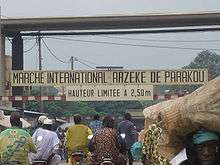
There are several markets trading, notably the largest, Grand Marché Azeke which one of the largest in Benin, an international market spanning over a block.[4] This market has a large covered hall overlapping onto the streets with stalls, with 500 and 1000 vendors. The market sells an enormous range of goods from items of pottery including vases and bowls, to cotton textiles, cassettes and CD's of local and international artists, local spices, fruits, gasaru/wagasi (cow's milk cheese) and kitchen utensils.[5] Another market, located several blocks north, is called the "Marché Kobo Kobo", which lies across the street from the French Cultural Centre.[3] Marché Kobo Kobo is known for its clothing retailing, primarily second hand goods, and in another section livestock.[3] The Marché Depot is located near Parakou Railway Station around numerous hotels and sells mostly food but also calabashes and baskets. There is also the Marché Guema, located next to Guema Church on the northern road to Malanville in the Albarika quarter of the city. The market was founded by the Somba people of the Atacora, and takes place every Sunday at 10 am. The market consists of a collection of grass huts, and specialises in beef and pork and local millet beer known as choukachou or simply "chouk".[5]
Demographics
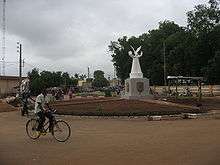
The name, Parakou, is derived from a Dendi word meaning "the city of everyone", named for the city's diversity of ethnicities.[5] As a market town attracting many people as a trading and stop-off point, Parakou has a large mix of African ethnicities, including Dendi, Somba, Fon, Mina, Bariba, Djerma, Yoruba (of the Nago tribe), Hausa, Kabrais, Warma, Fula,[6] and Tuareg.[5]
In 1979 the city was reported as having 60,915 people and according to the official census of 1992, Parakou had a population of 103,577. In the last 15–20 years the population of Parakou has nearly doubled with 149,819 recorded in 2002 and with the most recent census in 2013, the population was 255,478.[7]
Climate
| Climate data for Parakou (1961–1990) | |||||||||||||
|---|---|---|---|---|---|---|---|---|---|---|---|---|---|
| Month | Jan | Feb | Mar | Apr | May | Jun | Jul | Aug | Sep | Oct | Nov | Dec | Year |
| Record high °C (°F) | 36.6 (97.9) |
38.3 (100.9) |
38.9 (102.0) |
38.4 (101.1) |
35.9 (96.6) |
33.7 (92.7) |
32.1 (89.8) |
31.6 (88.9) |
32.2 (90.0) |
33.9 (93.0) |
35.5 (95.9) |
35.8 (96.4) |
38.9 (102.0) |
| Average high °C (°F) | 34.1 (93.4) |
36.0 (96.8) |
36.2 (97.2) |
34.9 (94.8) |
32.8 (91.0) |
30.7 (87.3) |
29.2 (84.6) |
28.6 (83.5) |
29.5 (85.1) |
31.5 (88.7) |
33.6 (92.5) |
33.6 (92.5) |
32.6 (90.7) |
| Daily mean °C (°F) | 26.5 (79.7) |
28.7 (83.7) |
29.6 (85.3) |
29.0 (84.2) |
27.5 (81.5) |
26.1 (79.0) |
25.1 (77.2) |
24.7 (76.5) |
25.0 (77.0) |
26.1 (79.0) |
26.6 (79.9) |
26.1 (79.0) |
26.8 (80.2) |
| Average low °C (°F) | 18.9 (66.0) |
21.3 (70.3) |
22.9 (73.2) |
23.1 (73.6) |
22.2 (72.0) |
21.4 (70.5) |
21.0 (69.8) |
20.8 (69.4) |
20.5 (68.9) |
20.8 (69.4) |
19.7 (67.5) |
18.5 (65.3) |
20.9 (69.6) |
| Record low °C (°F) | 15.8 (60.4) |
18.2 (64.8) |
19.9 (67.8) |
19.9 (67.8) |
19.2 (66.6) |
18.9 (66.0) |
19.0 (66.2) |
19.1 (66.4) |
18.5 (65.3) |
18.6 (65.5) |
16.7 (62.1) |
15.2 (59.4) |
15.2 (59.4) |
| Average precipitation mm (inches) | 3.8 (0.15) |
9.2 (0.36) |
39.4 (1.55) |
85.5 (3.37) |
130.8 (5.15) |
172.0 (6.77) |
189.9 (7.48) |
208.8 (8.22) |
205.6 (8.09) |
91.1 (3.59) |
6.3 (0.25) |
6.6 (0.26) |
1,149 (45.24) |
| Average precipitation days (≥ 1.0 mm) | 0 | 1 | 3 | 5 | 9 | 11 | 12 | 13 | 15 | 7 | 1 | 1 | 78 |
| Source: NOAA[8] | |||||||||||||
Culture
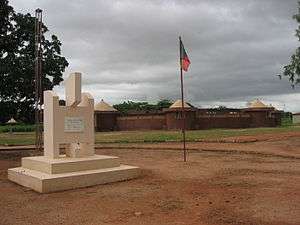
The city has a museum, the Musée en Plein Air de Parakou.[3]
Administration
Parakou is one of the 77 official communes of Benin. The mayor of the commune and city as of 2008 is Samou Seidou Adambi.
Villages
The commune of Parakou contains the following villages:[9]
Amawihon, Bakaga, Bakounkparou, Bakounourou, Baperou, Bereyadou, Borarou, Darou Kourarou, Debregourou, Dokparou, Douerou, Forane Kparou, Gagbebou, Ganou, Ga Yakabou, Gommboko, Gorobani, Gouforou, Goutere, Guema, Guererou, Guinrerou, Kaborokpo, Kabro, Karobouarou, Kipare, Konkoma, Koumerou, Kperou Guera, Moundouro, Nekinparo, Nikikperou, Ouroungourou, Pepekino, Pepepeterou, Sanro, Senouorou, Sokoumeno, Sokouno, Sonoumo, Sourou, Suinrou, Tabayorourou, Tankaro, Tankaro Ga, Teougourou Gando, Tian, Tinekonparou, Tora, Tourou, Wansirou, Weria, Wore, Worora, Yakassirou
Education
The University of Parakou was founded in 2001.
Places of worship
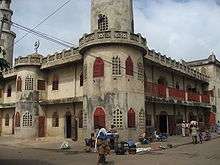
Among the places of worship, most predominant are Muslim mosques.[10] There are also several Christian denominations represented: Roman Catholic Archdiocese of Parakou (Catholic Church), Protestant Methodist Church in Benin (World Methodist Council), Baptist Church of Benin (Baptist World Alliance), Living Faith Church Worldwide, Redeemed Christian Church of God and the Assemblies of God.
Transport
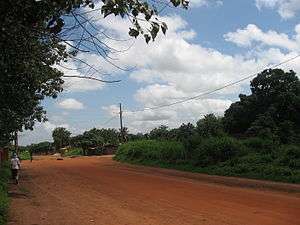
Parakou Railway Station is the last railway station on the Parakou-Cotonou railway, however at present it is not open to passenger transportation.[3] Both the national highways RNIE 2 and RNIE 6 pass through Parakou. The city is also served by Parakou Airport.[3] The government has proposed extending the railway to Dosso in Niger.[11]
Sport
The main football clubs are Dynamo Unacob FC de Parakou and Buffles du Borgou FC which play in the Benin Premier League, the highest division of Beninese football.
Notable people
- Hubert Maga - First President of Dahomey (the former name of Benin).[12]
- Steve Mounié - Professional footballer who plays in England for Huddersfield Town in the Premier League and has been capped by Benin at senior international level.[13]
References
- "World Gazetteer". World Gazetteer. Archived from the original on January 11, 2013. Retrieved July 27, 2013.
- Mathurin C. Houngnikpo, Samuel Decalo, Historical Dictionary of Benin, Rowman & Littlefield, USA, 2013, p. 281
- Butler, Stuart (2019) Bradt Travel Guide - Benin, pgs. 177-180
- Butler 2006, p. 192.
- "Parakou". Benintourism.com. Retrieved January 10, 2009.
- In Fula: Fulɓe; in French: Peul or Peulh.
- "Benin: largest cities and towns and statistics of their population". World Gazeteer. Archived from the original on May 22, 2011. Retrieved January 10, 2009.
- "Parakou Climate Normals 1961–1990". National Oceanic and Atmospheric Administration. Retrieved January 13, 2015.
- "Parakou". Maplandia World Gazetteer. Retrieved January 11, 2009.
- J. Gordon Melton, Martin Baumann, ‘‘Religions of the World: A Comprehensive Encyclopedia of Beliefs and Practices’’, ABC-CLIO, USA, 2010, p. 338
- "EXTENDING FROM BENIN TO NIGER". Railways Africa. Retrieved October 17, 2010.
- Matthews 1966, p. 139
- "Benin – S. Mounié – Soccerway – Results, fixtures, tables and statistics". Soccerway. Retrieved August 15, 2013.
Bibliography
| Wikimedia Commons has media related to Parakou. |
- Matthews, Ronald (1966). "African Powder Keg: Revolt and Dissent in Six Emergent Nations". London: The Bodley Head. OCLC 246401461. Cite journal requires
|journal=(help)CS1 maint: ref=harv (link). - Butler, Stuart (2006). "Benin". Guilford, Connecticut: Bradt Travel Guides, The Globe Pequot Press. Cite journal requires
|journal=(help)CS1 maint: ref=harv (link)
